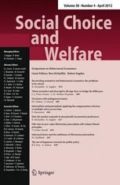Social Choice and Welfare, vol 38(4). pp. 369-584. (2012)
Autores: José Luis Pinto Prades y José María Abellán Perpiñán.
Revealed preferences are not consistent. Many anomalies have been found in different contexts. This finding leads to a divergence between normative and descriptive analyses. There are several ways of facing this problem. In this paper we argue in favour of debiasing observed choices in such a way that the “true” preferences are discovered.
Our procedure is based on quantitative corrections derived from assuming the descriptive validity of prospect theory and the normative validity of expected utility theory. Those corrective formulas were first applied by Bleichrodt et al. (Manag Sci 47:1498–1514, 2001). We explain here how such formulas can be used to avoid inefficient allocation of health care resources. This approach shares the philosophy of libertarian paternalism (LP). However, it reduces some of the potential problems of LP: the definition of error (and the need to nudge people) is more clear and objective. In this sense, it reduces the chances that the regulator tries to nudge people toward behaviour based on her preferences rather than those of the people she is nudging.

